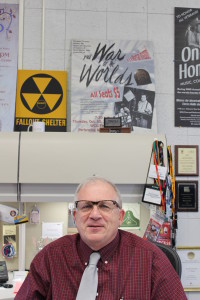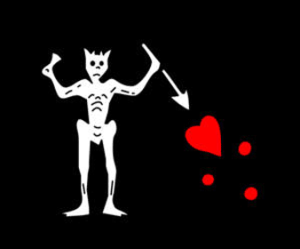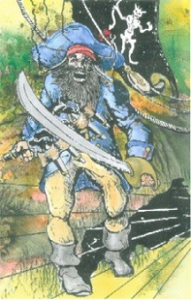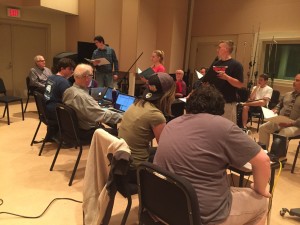Pirates, Nazis, war, oh my!
“Blackbeard’s Ghost and The Queen Anne’s Revenge”, a radio show brought to stage, offered a swashbuckling adventure to the audience present at its one-time performance in Western Carolina University’s Bardo Fine and Performing Arts Center on Thursday evening.
The history-based production was written and produced by WCU’s Communication Department Head, Don Connelly, who put in nearly a year of work and research to bring the humorous and mystery-filled show to life.

Don Connelly, wrote and produced the “Blackbeard’s ghost and the Queen Anne’s Revenge.” This was his 8th radio show.
The performance was directed by Peter Savage, a visiting assistant professor of stage and screen.
“Blackbeard’s Ghost” followed the tale of Seaman Robert Martin, a young man who found himself on the North Carolina coast as a part of the Coast Guard in World War II. Martin, along with his rambunctious but reliable stallion Satan, served as the first line of defense against Nazi spies and saboteurs trying to make their way onto American soil.
Martin and Satan would ride along the dunes and sandy beaches of Jockey’s Ridge and Nags Head, NC, keeping an eye out for Nazi U-boats and any other potential threats.
One night Martin found a gold coin on the beach, a gold coin his loud and drunken fisherman pal, Ed, swore was a coin from the infamous pirate Blackbeard’s crew.
Ed immediately said it could only mean one thing: Martin was a descendent of one of Blackbeard’s crew members and that meant he was a pirate by blood. Ed said the coin was expelled onto the shore from Davy Jones’ Locker, and Martin was destined to find it. He was bound to secrecy, and compelled to carry the coin everywhere he went.

Blackbeard’s flag symbol, via FlagLine.
After carrying the coin with him, Martin decided to lure a Nazi U-boat to the shore by using one of Blackbeard’s niftiest tricks – he ties a lantern to Satan and puts ropes around the horse’s legs so that he wobbles along the dunes of the beach. The plan works; a Nazi U-boat mistook Satan’s wobbling lantern for another ship and tried to follow it, eventually getting stuck on a sandbar.
The Navy was sent to help, but before they could arrive, an 18th century pirate ship appeared out of nowhere, and a wild, fervent Blackbeard ordered his crew to fire the cannons.
The Nazi U-boat was destroyed by the Queen Anne’s Revenge, and Blackbeard and his ship vanish, leaving only the traces of cannon fire.
Astonishingly, Martin later found that his rum-loving fisherman friend Ed’s full name was Edward Teach, the birth name of the notorious Blackbeard. Before giving away too many details, the old pirate turns and walks down the beach in laughter, his footprints disappearing behind him.
In the present day, Martin tells this story to his great grandson, Robbie, who is also a pirate by blood. Read the entire “Blackbeard’s Ghost” story line here.
As Connelly explained, every location mentioned in “Blackbeard’s Ghost” is a real place, and many of the folks named in the production were real people. Places like Saint Andrews Chapel and Sambo Tillet’s Restaurant can still be found today.

An illustration of the infamous Blackbeard, via wcu.edu
“I had to use longitude and latitude to locate the Coast Guard stations,” Connelly said. As one might imagine, today’s Nags Head looks nothing like it did in the 1940s, so Connelly put much work into creating the story line that relied so much on location.
The Asheville Symphony Orchestra, alongside WCU music students, provided the musical underscore for the production on stage. The music for “Blackbeard’s Ghost” was composed by Bruce Frazier, a WCU School of Music professor.
Through special arrangement with the Walt Disney Company, the orchestra was able to begin the radio show with an orchestrated version of a medley from the beloved “Pirates of the Caribbean” films.
“Blackbeard’s Ghost” was intended to pay tribute to the “golden age of radio.” All the actors and actresses wore tuxedos and gowns, vintage microphones were used for sound and an old light box was used to tell the audience when applause was appropriate and when they were recording live.

“Blackbeard’s Ghost” cast practices for Thursday’s performance. Photo by Julia Hudgins.
“It’s done in the style of [the golden age] the way we present it on stage is how it would be done and how it was done in 1938 when the networks would take a radio show out to a major theater,” Connelly said. “It’s completely different [from other shows] from the standpoint of the orchestra, the actors, the sound effects, are all together on the stage.”
Everything that might be done by the press of a button in other productions, the cast and crew behind “Blackbeard’s Ghost” did live. According to Connelly, actors in other plays have learned to work around a production’s pre-recorded music, while the actors on Thursday night got to work with a live musical underscore.
Connelly said the production was inspired by a photograph he found of a young seaman on the coast.
Although not a full house, it is safe to say that his inspiration was a hit among audience members, and the convincing buccaneer-like dialogue elicited some giggles throughout the show. After the dramatic closing, the crowd rose in standing ovation as the actors and musicians took their much-deserved bow.



